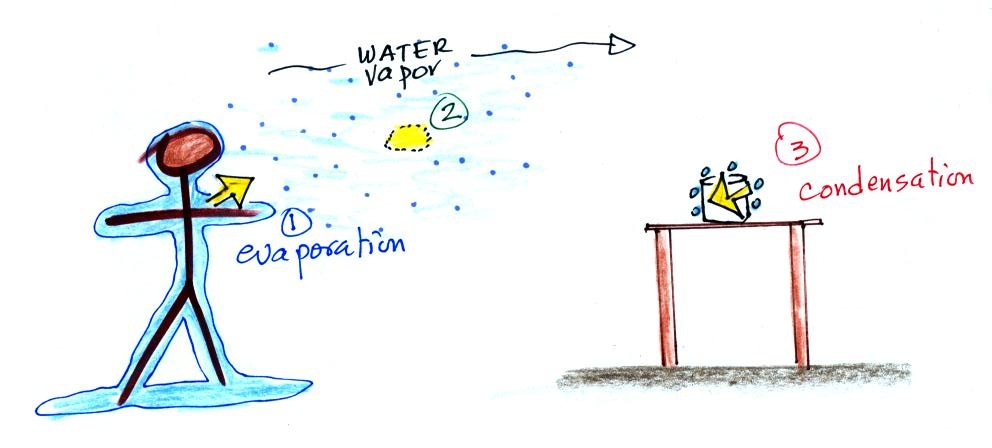
1. The person in the bathroom has just
stepped out of the shower and is covered with water.
Some of the water evaporates and that requires
energy. In this case the energy is taken from you
body.
2. The energy isn't lost, it's "stored" in the water vapor which travels into the kitchen.
3. The energy reappears in the kitchen when the water vapor condenses onto the cold can.
Here's the figure I usually use to illustrate latent heat energy transport.
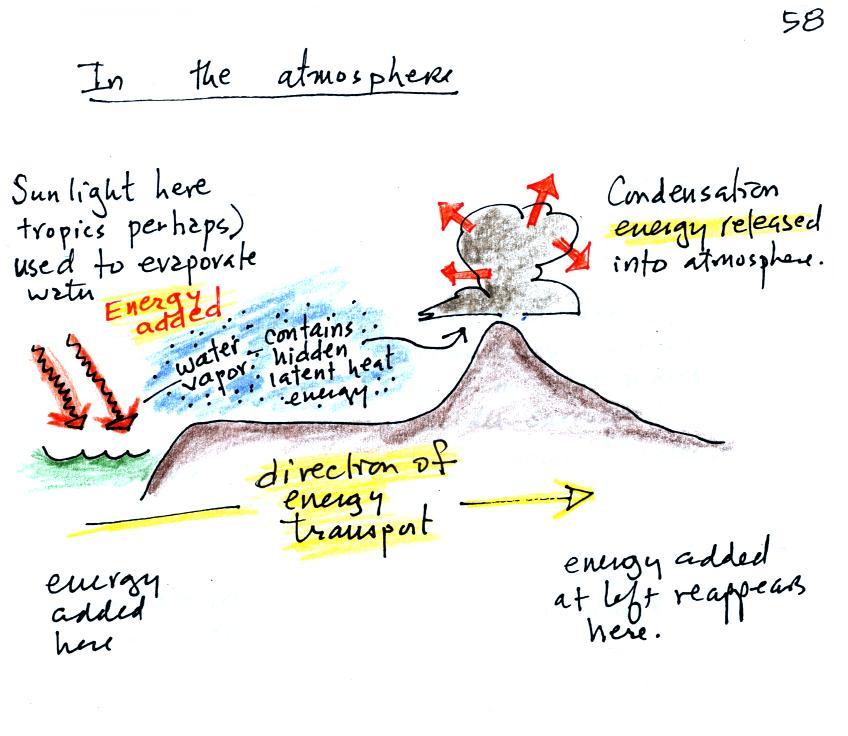
This figure shows how energy can be transported from one
location to another in the form of latent heat. The
story starts at left in the tropics where there is often an
abundance or surplus of sunlight energy. Some of the
incoming sunlight evaporates ocean water. The resulting
water vapor moves somewhere else and carries hidden latent
heat energy with it. This hidden energy reappears when
something (air running into a mountain and rising, expanding,
and cooling) causes the water vapor to condense. The
condensation releases energy into the surrounding
atmosphere. This would warm the air.
Energy arriving in sunlight in the tropics has effectively been transported to the atmosphere in a place like Tucson.
Here's something I slipped into the notes from Wednesday's class but mentioned today. The figure below lists and illustrates the 4 processes that cause air to rise. Rising air is important because it can cause clouds to form.
2. The energy isn't lost, it's "stored" in the water vapor which travels into the kitchen.
3. The energy reappears in the kitchen when the water vapor condenses onto the cold can.
Here's the figure I usually use to illustrate latent heat energy transport.

Energy arriving in sunlight in the tropics has effectively been transported to the atmosphere in a place like Tucson.
Here's something I slipped into the notes from Wednesday's class but mentioned today. The figure below lists and illustrates the 4 processes that cause air to rise. Rising air is important because it can cause clouds to form.

Wind is blowing up and over an obstacle in
the fourth sketch above. This is new and is called
orographic or topographic lifting. Clouds would be found
on the upslope side of the mountain. The sinking air on
the downwind side warms and keeps clouds from forming.
One side of a mountain can be green and lush because of
abundant precipitation. The other side could be dry and
covered less and different vegetation. This is the rain
shadow effect and will come up again later in the course.
We've covered three energy transport
processes so far: conduction, convection, and latent heat.
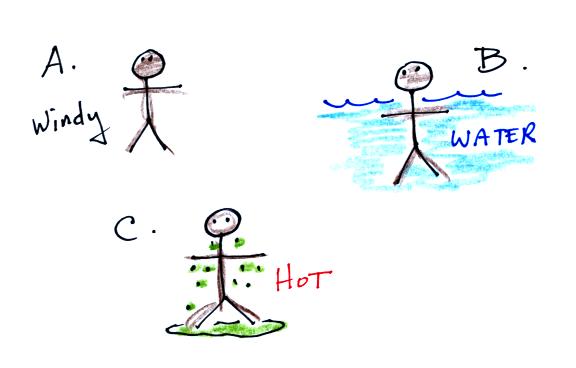
Can you match each picture in the figure
above with the energy transport process it illustrates
best? You'll find the answers at the end of today's
notes.
At last, It's time to tackle electromagnetic (EM) radiation
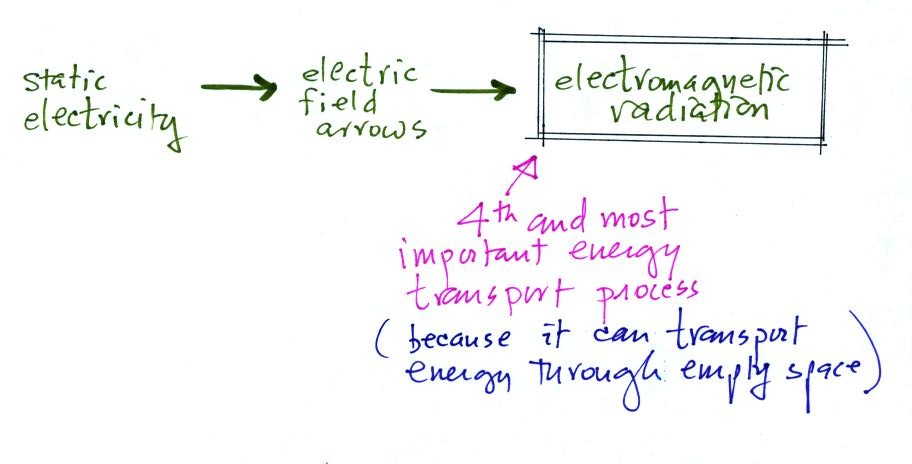
First we need to review a couple of rules concerning static electricity and learn something about electric field arrows. The static electricity rules are found at the top of p. 59 in the photocopied ClassNotes

Two electrical charges with the same polarity push each
other apart. Opposite charges are attracted to each
other.
There's a demonstration of these static electricity rules that I would like to be able to show you. I haven't been able to get it to work very well however. The demonstration involves a Van de Graaff generator, something that produces a lot of electric charge and high voltage. A wire connects the dome of the generator to a small wand used to blow bubbles. Because of the connection to the generator the bubbles are positively charged. As they drift toward the dome of the generator the positive charge repels them and they move away.

One of the big problems I've been having is with the bubbles. They don't last very long and sink to quickly. While I haven't been able to get the demonstration working very well I did find a video that you can watch and see how things should work.
Now the concept that we will be using, electric field arrows. Electric field arrows (or just the E field) show you the direction and give you an idea of the strength of the electrical force that would be exerted on a positive charge located at that point.

Finally a couple of questions to test your understanding,
neither of these questions was
shown in class.


Now we'll use what we know about electric fields to start
to understand electromagnetic radiation.
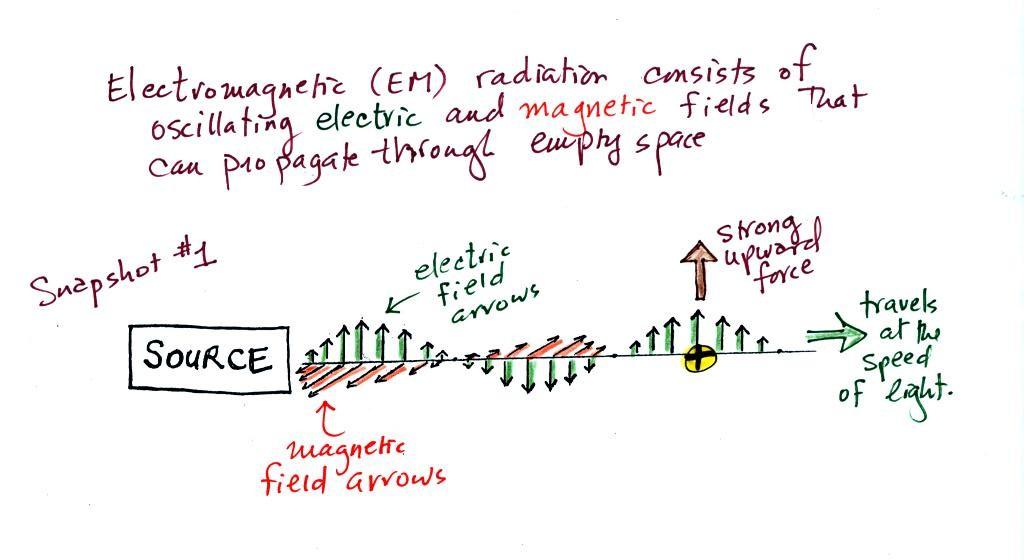
We imagine turning on a source of EM radiation and then a very short time later we take a snapshot. In that time the EM radiation has traveled to the right (at the speed of light). The EM radiation is a wavy pattern of electric and magnetic field arrows. We'll ignore the magnetic field lines. The E field lines sometimes point up, sometimes down. The pattern of electric field arrows repeats itself.
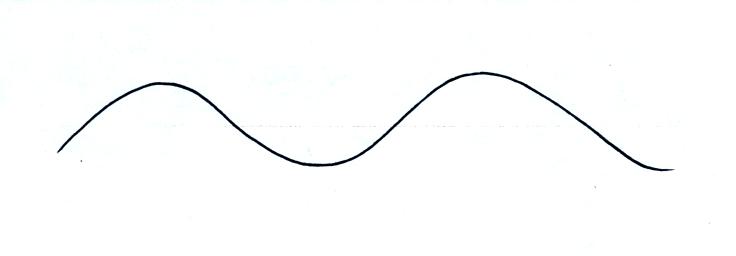
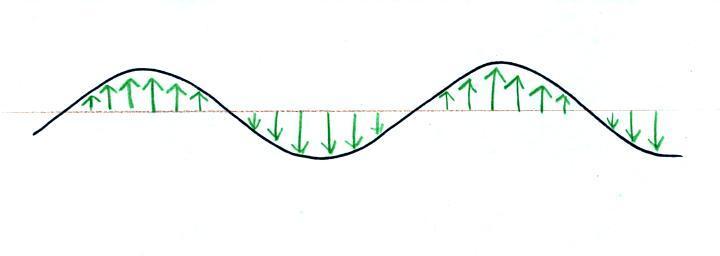
The wavy line just connects the tips of a bunch of
electric field arrows.
Note the + charge
near the right side of the picture. At the time this
picture was taken the EM radiation exerts a fairly strong
upward force on the + charge (we use the E field arrow at the
location of the +
charge to determine the direction and strength of the force
exerted on the +
charge).
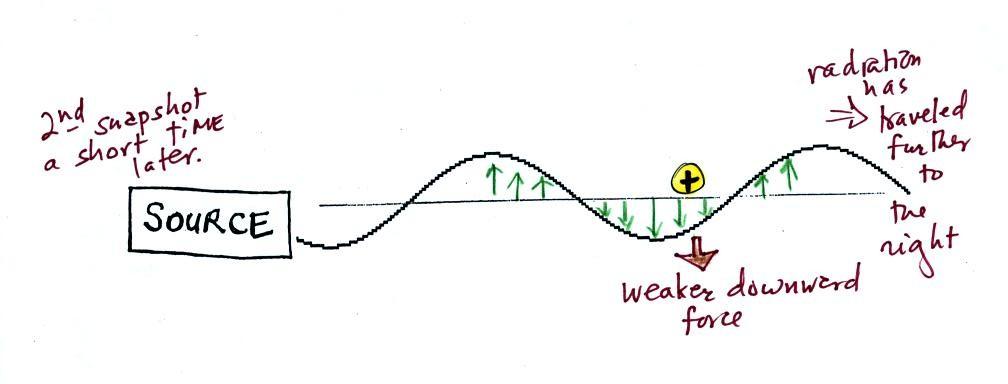


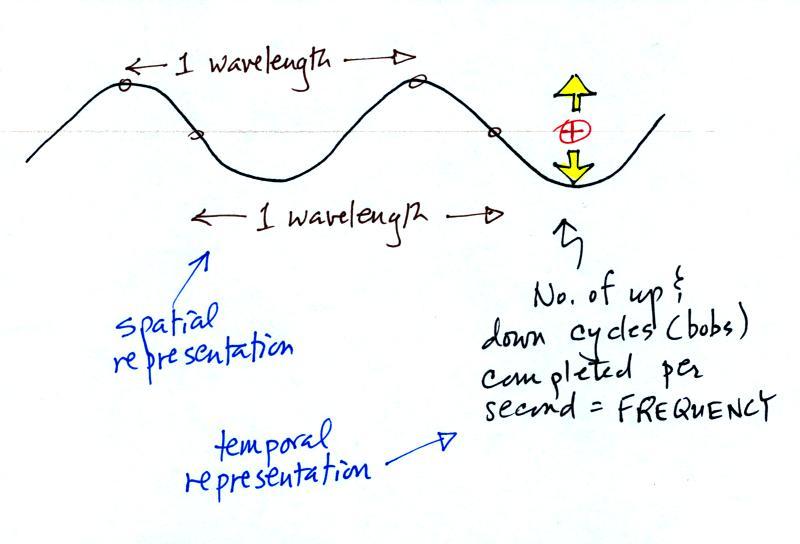
Or you can describe the radiation temporally using the frequency of oscillation (number of up and down cycles completed by an oscillating charge per second). By temporally we mean you look at one particular fixed point and look at how things change with time.
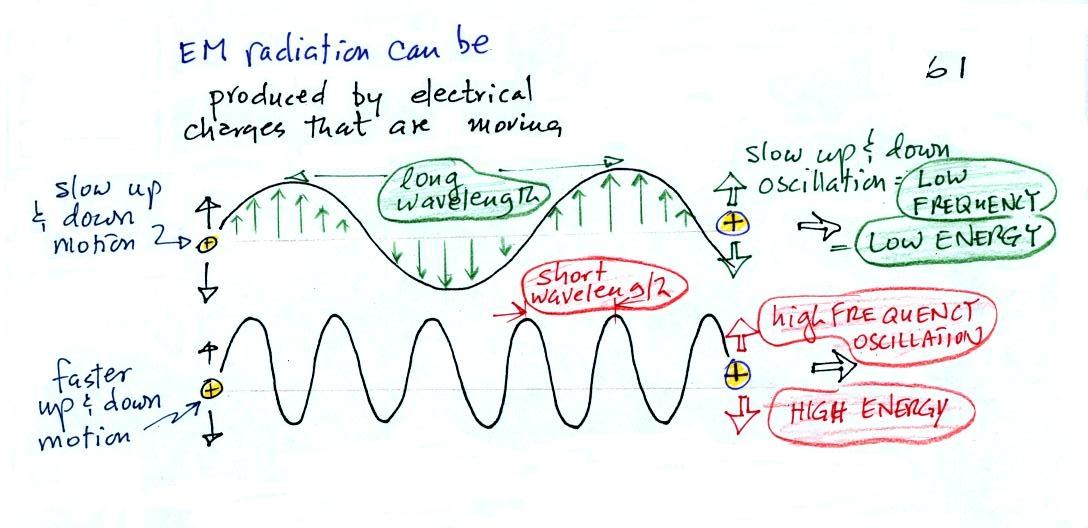
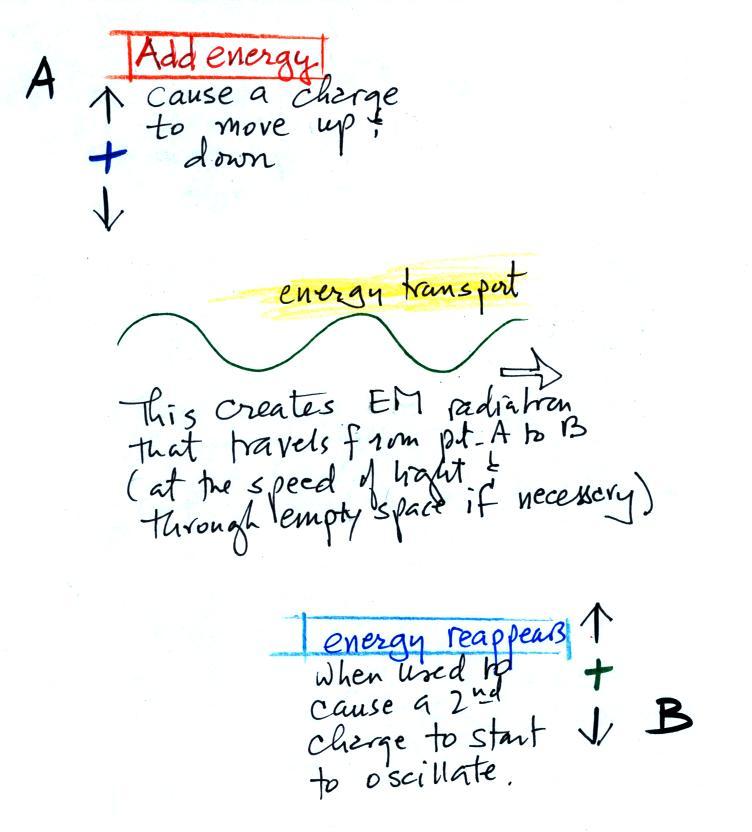
Once the EM radiation encounters an electrical charge at
another location (bottom right), the energy reappears as the
radiation causes the charge to move. Energy has been
transported from left to right.
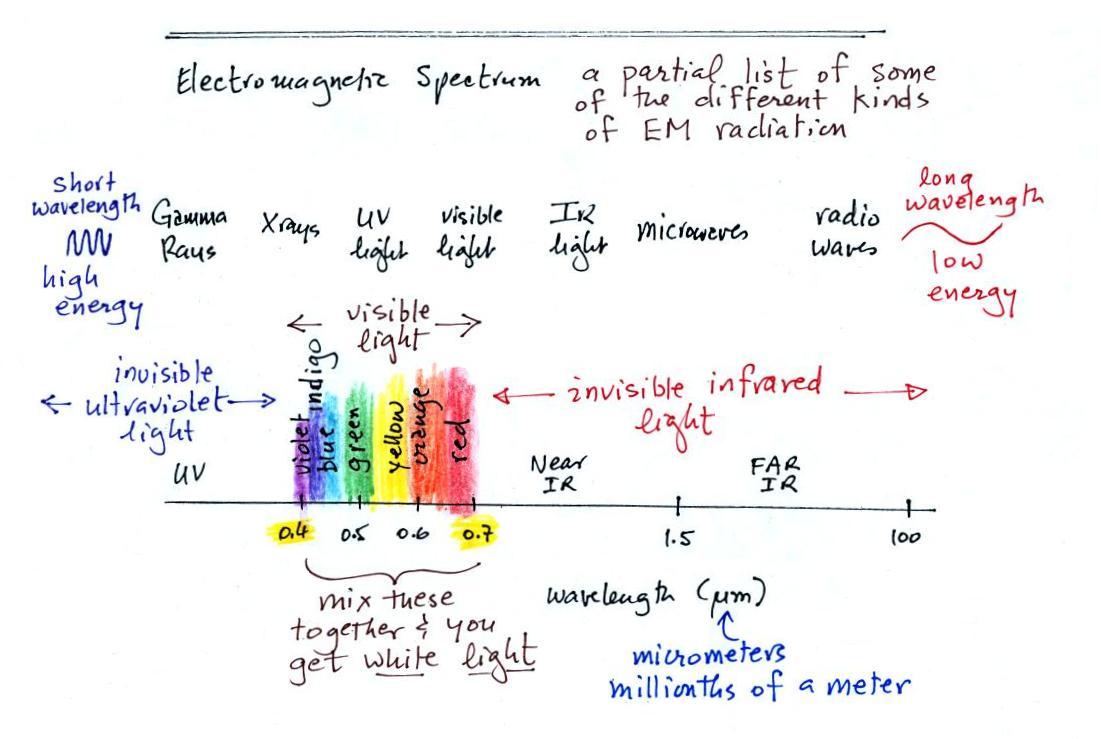
This is really just a partial list of some of the different types of EM radiation. In the top list, shortwave length and high energy forms of EM radiation are on the left (gamma rays and X-rays for example). Microwaves and radiowaves are longer wavelength, lower energy forms of EM radiation.
We will mostly be concerned with just ultraviolet light (UV), visible light (VIS), and infrared light (IR). Note the micrometer (millionths of a meter) units used for wavelength for these kinds of light. The visible portion of the spectrum falls between 0.4 and 0.7 micrometers. UV and IR light are both invisible. All of the vivid colors shown above are just EM radiation with slightly different wavelengths. When you see all of these colors mixed together, you see white light.
Here are the answers to several questions embedded in today's notes.
#1

At last, It's time to tackle electromagnetic (EM) radiation

First we need to review a couple of rules concerning static electricity and learn something about electric field arrows. The static electricity rules are found at the top of p. 59 in the photocopied ClassNotes

There's a demonstration of these static electricity rules that I would like to be able to show you. I haven't been able to get it to work very well however. The demonstration involves a Van de Graaff generator, something that produces a lot of electric charge and high voltage. A wire connects the dome of the generator to a small wand used to blow bubbles. Because of the connection to the generator the bubbles are positively charged. As they drift toward the dome of the generator the positive charge repels them and they move away.

One of the big problems I've been having is with the bubbles. They don't last very long and sink to quickly. While I haven't been able to get the demonstration working very well I did find a video that you can watch and see how things should work.
Now the concept that we will be using, electric field arrows. Electric field arrows (or just the E field) show you the direction and give you an idea of the strength of the electrical force that would be exerted on a positive charge located at that point.

In this figure (p. 59 in
the ClassNotes) a positive charge has been placed at 3
locations around a center charge. The electric
field arrow shows the direction of the force that would
be exerted on each of the charges. The force arrow
is shown in blue. The forces range from weak to
strong depending on the distance between the two
charges.
The E field arrows tell you what will happen to a + charge. but you can use the arrows to determine what will happen to a - charge also.

For a negative charge the force will point in a direction opposite the E field arrow.
The E field arrows tell you what will happen to a + charge. but you can use the arrows to determine what will happen to a - charge also.

For a negative charge the force will point in a direction opposite the E field arrow.

What is the direction of
the electric field arrow at Point X halfway between a +
and a - charge?
The second question has two parts. First you need to determine what polarity of charge must be on ground to cause the charges in the figure below to move as they are doing. Then what direction does the electric field arrow point at a location just above the ground where the two charges are found.
The second question has two parts. First you need to determine what polarity of charge must be on ground to cause the charges in the figure below to move as they are doing. Then what direction does the electric field arrow point at a location just above the ground where the two charges are found.

You'll find the answers
to both questions at the end of today's notes.
An electric field arrow
shows the direction and
gives an idea of the strength
of the electrical force
that would be exerted on a positive charge
You'll find most of the following on p. 60 in the
photocopied ClassNotes. shows the direction and
gives an idea of the strength
of the electrical force
that would be exerted on a positive charge

We imagine turning on a source of EM radiation and then a very short time later we take a snapshot. In that time the EM radiation has traveled to the right (at the speed of light). The EM radiation is a wavy pattern of electric and magnetic field arrows. We'll ignore the magnetic field lines. The E field lines sometimes point up, sometimes down. The pattern of electric field arrows repeats itself.

Textbooks often represent
EM radiation with a wavy line like shown above. They don't
usually explain what the wavy line represents.


Th picture above was taken a
short time after the first snapshot aftere the radiation had
traveled a little further to the right. The EM
radiation now exerts a somewhat weaker downward force on the
+ charge.

A 3rd snapshot taken a short
time later. The +
charge is now being pushed upward again.
A movie of the + charge, rather than just a series of snapshots, would show the charge bobbing up and down much like a swimmer in the ocean would do as waves passed by.
A movie of the + charge, rather than just a series of snapshots, would show the charge bobbing up and down much like a swimmer in the ocean would do as waves passed by.

The wavy pattern used to
depict EM radiation can be described spatially (what
you would see in a snapshot) in terms of its wavelength, the
distance between identical points on the pattern.

Or you can describe the radiation temporally using the frequency of oscillation (number of up and down cycles completed by an oscillating charge per second). By temporally we mean you look at one particular fixed point and look at how things change with time.

EM radiation can be created
when you cause a charge to move up and down. If
you move a charge up and down slowly (upper left in the
figure above) you would produce long wavelength radiation
that would propagate out to the right at the speed of
light. If you move the charge up and down more rapidly
you produce short wavelength radiation that propagates at
the same speed.
Once the EM radiation encounters the charges at the right side of the figure above the EM radiation causes those charges to oscillate up and down. In the case of the long wavelength radiation the charge at right oscillates slowly. This is low frequency and low energy motion. The short wavelength causes the charge at right to oscillate more rapidly - high frequency and high energy.
These three characteristics: long wavelength / low frequency / low energy go together. So do short wavelength / high frequency / high energy. Note that the two different types of radiation both propagate at the same speed.
The following figure illustrates how energy can be transported from one place to another (even through empty space) in the form of electromagnetic (EM) radiation.
Once the EM radiation encounters the charges at the right side of the figure above the EM radiation causes those charges to oscillate up and down. In the case of the long wavelength radiation the charge at right oscillates slowly. This is low frequency and low energy motion. The short wavelength causes the charge at right to oscillate more rapidly - high frequency and high energy.
These three characteristics: long wavelength / low frequency / low energy go together. So do short wavelength / high frequency / high energy. Note that the two different types of radiation both propagate at the same speed.
The following figure illustrates how energy can be transported from one place to another (even through empty space) in the form of electromagnetic (EM) radiation.

You add energy when you
cause an electrical charge to move up and down and create
the EM radiation (top left).
In the middle figure, the EM
radiation that is produced then travels out to the right (it
could be through empty space or through something like the
atmosphere).

This is really just a partial list of some of the different types of EM radiation. In the top list, shortwave length and high energy forms of EM radiation are on the left (gamma rays and X-rays for example). Microwaves and radiowaves are longer wavelength, lower energy forms of EM radiation.
We will mostly be concerned with just ultraviolet light (UV), visible light (VIS), and infrared light (IR). Note the micrometer (millionths of a meter) units used for wavelength for these kinds of light. The visible portion of the spectrum falls between 0.4 and 0.7 micrometers. UV and IR light are both invisible. All of the vivid colors shown above are just EM radiation with slightly different wavelengths. When you see all of these colors mixed together, you see white light.
Here are the answers to several questions embedded in today's notes.
#1

Fig. A. The wind should make you
think wind chill which is energy transport by
convection.
Fig. B. You can only survive about 30 minutes in 40 F water like might be happening here. Water transports energy away from your body by conduction so quickly that your body can't replace it. Note latent heat energy transport isn't involved here because there isn't a phase change.
Fig. C. It might be a little hard to tell but this person is sweating. Some of the sweat is dripping but the rest is evaporating. The evaporation takes energy from your body and cools you. So latent heat energy transport is involved here.
#2
To answer the first question we imagine placing a + charge at Point X.

The center charge will be repelled by the charge on the
left and attracted to the charge on the right. The
center charge would move toward the right.

The electric field arrow shows the direction of the
force on the center charge. The electric field arrow
should point toward the right.
#3
The ground can be either negatively or positively charged. If the ground were negatively charged the positive charge would be attracted to the ground and the negative charge repelled and pushed upward. That's not what is happening. So the ground must be positively charged.

The positive charge is creating the force that causes
the positive charge to move upward. So that too must
be direction that the electric field arrow is pointing.
Fig. B. You can only survive about 30 minutes in 40 F water like might be happening here. Water transports energy away from your body by conduction so quickly that your body can't replace it. Note latent heat energy transport isn't involved here because there isn't a phase change.
Fig. C. It might be a little hard to tell but this person is sweating. Some of the sweat is dripping but the rest is evaporating. The evaporation takes energy from your body and cools you. So latent heat energy transport is involved here.
#2
To answer the first question we imagine placing a + charge at Point X.


#3
The ground can be either negatively or positively charged. If the ground were negatively charged the positive charge would be attracted to the ground and the negative charge repelled and pushed upward. That's not what is happening. So the ground must be positively charged.
